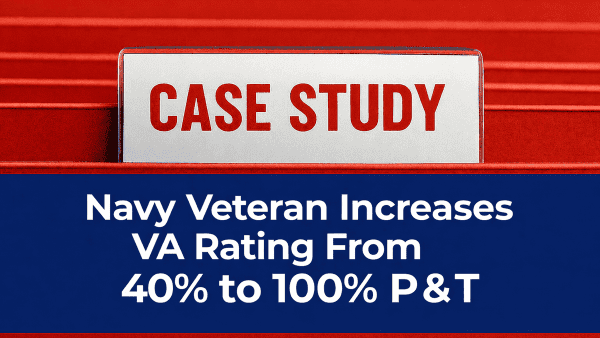Looking for Expert-Level VA Claim Answers?📱Call Us Now! 737-295-2226
Despite service members’ bold work for our country, they are inevitably exposed to irritants that can affect their quality of life. Disability benefits may be available to veterans exposed to specific irritants like gases, fumes, or smoke while serving, leading to reactive airway disease.
This guide details how you, as a veteran, may be entitled to VA compensation and benefits if you have been diagnosed with reactive airway disease directly linked to your service.
Table of Contents
Summary of Key Points
- Reactive Airway Disease (RAD) is a respiratory condition that causes asthma-like symptoms triggered by irritants such as fumes, smoke, and particulate matter—common exposures during military service.
- RAD is rated analogously to bronchial asthma under Diagnostic Code 6602, with VA disability ratings ranging from 10% to 100%, based on FEV-1/FVC test results and treatment frequency.
- Veterans may qualify for VA compensation if they can provide medical evidence connecting RAD to in-service exposures like burn pits, sulfur fires, or other toxic airborne hazards.
What is Reactive Airway Disease?

Reactive Airway Disease (RAD) refers to several respiratory illnesses causing the bronchial tubes in your lungs to react to an outside irritant, like gasses, fumes, mildew, or mold.
While RAD is considered a generic non-medical term, and you’ll find doctors using it to describe many breathing issues, including:
- COPD
- Asthma
- Inflammation
- Difficulty breathing
- Uncontrolled mucus production
- Congestive heart failure
Reactive airway disease shouldn’t be confused with Reactive Airway Dysfunction Syndrome (RADS), typically a one-time condition from inhaling vapors or corrosive gas. In addition, while RAD is closely related to asthma, the two are different.
Read our VA Disability Rating for Asthma Explained for more.
Symptoms
RAD is frequently compared to asthma due to similar symptoms veterans often find. There are various symptoms of reactive airway disease, including the following:
- Shortness of breath
- Wheezing
- Consistent cough that doesn’t go away
- Tightness in the chest
- Difficulty breathing
It’s important to understand that the symptoms you experience may vary from another veteran. For example, symptoms can be mild in some, while others experience life-threatening side effects that require immediate attention.
Risk Factors
Several contributing factors increase your risk for reactive airway disease, including:
- Cigarette smoke exposure
- Exposure to toxins, smoke, and other chemicals
- Allergies
- Family history of asthma or reactive airway disease
- Specific careers, including police, fire department, cleaners, emergency service workers, welders, and farmers
What Causes Reactive Airway Disease in Veterans?
Veterans who were exposed to airborne hazards, toxic fumes from sulfur fires and/or open-air burn pits could be at risk of having Reactive Airway Disease.
Here’s a closer look at the top three causes of reactive airway disease in veterans.
Sulfur Mines
Veterans in contact with hydrogen sulfide and sulfur dioxide gasses while in-service have been known to develop breathing problems. Those affected may experience irritation in the eyes, throat, nose, and coughing.
In addition, service members exposed to high levels of sulfur dioxide might experience airway obstruction affecting their quality of life. For example, in 2003, a fire ignited at the Mishraq State Sulfur Mine Plant near Mosul, Iraq, and burned for nearly a month.
Service members exposed to the fires experienced minor burns, blood-tinged nasal mucus, and irritation. Veterans might be eligible for VA benefits if exposed to the mine fire.
Burn Pits
Veterans who served in Iraq, Djibouti, and other areas of the Southwest Asian theater of military operations used burn pits to dispose of hazardous methods like diesel fuel, ammunition, and medical waste. While the system worked well to minimize the amount of trash, it also emitted poisonous smoke plumes.
The plumes released into the air contained carcinogens and hazardous pollutants, which can cause reactive airway disease. One of the largest burn pits was more than 10 acres and was found at Joint Base Balad.
Read our Burn Pit Symptoms: The Top 5 Things to Know to learn more.
Particulate Matter
Burn pits are also responsible for emitting particulate matter, a combination of liquid droplets and tiny particles that can be harmful if ingested or inhaled. Particulate matter was also found in Iraq and Afghanistan sandstorms.
The U.S. Department of Veteran Affairs (VA) announced a presumptive service connection in 2021 for veterans who had the following:
- Diagnosis of asthma, sinusitis, or rhinitis
- Served in Southwest Asia and certain additional areas
- Conditions presented themselves within 10 years of qualifying service
The presumptive service connection allows veterans to connect their conditions to their service more efficiently.
VA Ratings for Reactive Airway Disease
The reactive airway disease is rated analogously with bronchial asthma since they share the same symptoms and are categorized under the 38 C.F.R. § 4.97, Diagnostic Code (DC) 6602.
The reactive airway disease VA rating varies from 10%-100% and is based on the FEV1/FVC ratio, representing how well a person can exhale.
The Diagnostic Code 6602 ratings are the following:
100% Rating
- FEV–1 less than 40 percent predicted, or; FEV–1/FVC less than 40 percent, or
- More than one attack per week with episodes of respiratory failure or; requires daily use of systemic (oral or parenteral) high-dose corticosteroids or immunosuppressive medications
60% Rating
- FEV–1 of 40- to 55-percent predicted, or
- FEV–1/FVC of 40 to 55 percent, or
- At least monthly visits to a physician for required care of exacerbations, or
- Intermittent (at least three per year) courses of systemic (oral or parenteral) corticosteroids
30% Rating
- FEV–1 of 56- to 70-percent predicted, or
- FEV–1/FVC of 56 to 70 percent, or
- Daily inhalational or oral bronchodilator therapy, or
- Inhalational anti-inflammatory medication
10% Rating
- FEV–1 of 71- to 80-percent predicted, or
- FEV–1/FVC of 71 to 80 percent, or
- Intermittent inhalational or oral bronchodilator therapy
The service member must provide records of the attacks if there are no clinical findings of asthma or reactive airway disease during the examination.
Establishing Service Connection
As a veteran, you must provide the following information connecting your condition to receive VA benefits.
- Proof of an in-service illness, injury, or disease
- Diagnosis from your medical professional related to your reactive airway disease
- A medical connection between your current diagnosis and your in-service illness or injury (Independent Medical Opinion or Nexus Letter)
- Documentation of the severity of your illness
Since you can have reactive airway disease from other causes, like smoking or allergies, you must directly link your illness to your time serving. Therefore, keeping records of all doctor visits, medications, and other treatments you received for RAD is crucial.
Once veterans establish the connection of their service to the RAD diagnosis, they will receive the appropriate reactive airway disease VA rating.
Common Conditions Linked to Reactive Airway Disease
While asthma is the most common condition linked to reactive airway disease, there are several more you may experience.
COPD
While COPD has symptoms similar to reactive airway disease, the two differ. COPD is a chronic lung condition affecting your breathing and worsening over time.
Croup
Croup is commonly associated with infants but can occur at any age and cause coughing, difficulty breathing, swelling, and throat narrowing.
Bronchitis
Veterans may also experience bronchitis, leading to lung irritation, inflammation, shortness of breath, congestion, and coughing.
Emphysema
Also associated with smoking, emphysema is a severe lung disease that makes breathing difficult and damages your lung’s air sacs. It can also cause wheezing, chest tightness, and coughing.
Bronchiectasis
Bronchiectasis is a severe lung infection that can damage your airways and cause inflammation. Common symptoms include chest congestion, shortness of breath, and a persistent cough.
RAD Treatments
There are several medications veterans can take to treat reactive airway disease that is also used for asthma. Depending on the medication, you can expect quick relief from RAD or experience long-term control of symptoms.
You may be offered one of the following medications to help treat reactive airway disease.
- Corticosteroids – used to ease inflammation
- Bronchodilators – used to open airways
- Mast cell stabilizers and leukotriene inhibitors – used to prevent inflammation
According to the University of Pittsburgh Medical Center, you should limit exposure to specific irritants or conditions that trigger RAD, including:
- Smoke
- Allergies to pollen, dust, pets, and mold
- Exercise
- Strong odors
- Weather changes
Since not every trigger is avoidable, it’s best to understand the risks you face when exposing yourself to specific environments.
Conclusion
Reactive airway disease can seriously impact a veteran’s health and quality of life—and for many, it’s a direct result of exposure to hazardous conditions while serving.
Whether you’re experiencing persistent coughing, wheezing, or difficulty breathing, you may be entitled to VA disability benefits. If you’ve been diagnosed with RAD or a related respiratory condition, it’s time to get the compensation and care you deserve.
NEED MORE ASSISTANCE?
Most veterans are underrated for their disabilities and, therefore, not getting their due compensation. At VA Claims Insider, we educate and support you to understand and take control of the claims process, so you can get the rating and compensation you’re owed by law.
Our process takes the guesswork out of filing a VA disability claim and supports you every step of the way in building a fully-developed claim (FDC)—so you can increase your rating FAST!
If you’ve filed your VA disability claim and have been denied or have received a low rating—or you’re unsure how to get started—reach out to us! Take advantage of a VA Claim Discovery Call. Learn what you’ve been missing—so you can FINALLY get the disability rating and compensation YOU DESERVE!
About VA Claims Insider
- VA Claims Insider is the #1 most trusted name in VA disability claims.
- Work directly with a VA claims coach who can educate you to VA claim victory.
- 25,000+ disabled veterans have served in our membership programs since 2016.
- 30% average rating increase for veterans who complete our #1-rated Elite program.
- 4.7/5.0 average rating out of 5,500+ total reviews; over 4,500 5-star reviews.
Author

Eric Webb
Eric has written and worked in the field of Veterans Disability since 2020 and enjoys writing educational content for the veteran population. His prior work has been published in the Official Journal of the American College of Sports Medicine (ACSM). He holds a Degree in Health and Exercise Science.



